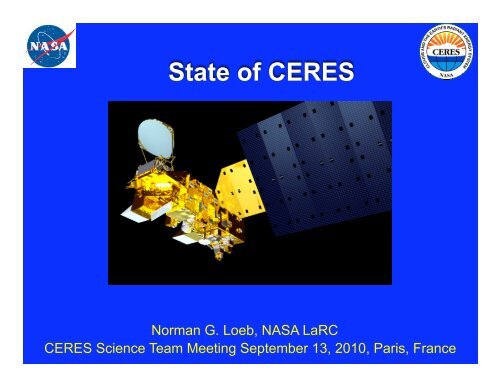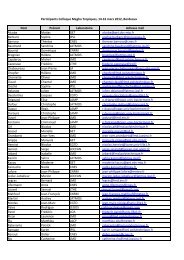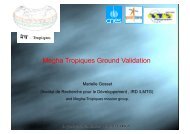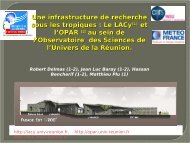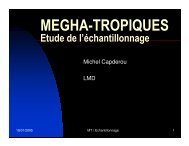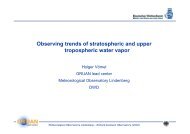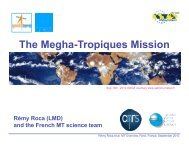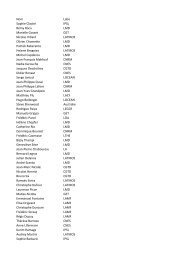State of CERES/NASA/EOS/Senior Reviews
State of CERES/NASA/EOS/Senior Reviews
State of CERES/NASA/EOS/Senior Reviews
You also want an ePaper? Increase the reach of your titles
YUMPU automatically turns print PDFs into web optimized ePapers that Google loves.
Norman G. Loeb, <strong>NASA</strong> LaRC<br />
<strong>CERES</strong> Science Team Meeting September 13, 2010, Paris, France
<strong>NASA</strong> Earth Science<br />
• <strong>NASA</strong> Administrator is Charles Bolden, Jr.<br />
• AA for Space and Earth Science is Ed Weiler.<br />
• Head <strong>of</strong> Earth Science is Mike Freilich.<br />
• Jack Kaye is Associate Director for R&A.<br />
• David Considine is <strong>NASA</strong> HQ Modeling lead and <strong>CERES</strong><br />
Program Scientist.<br />
• Hal Maring remains Radiation Sciences program lead.<br />
• Steve Volz is the Earth Science Deputy for Missions.<br />
• Richard Slonaker is Program Executive, <strong>NASA</strong>-HQ.
<strong>NASA</strong> Science Mission Directorate FY11 President’s Budget Request<br />
- Increases across the board from FY10 to FY15. Earth Science increases by 60%.<br />
- FY11 ES increases by $382 million over FY 2010 enacted, and $1.8 billion over 4-<br />
years (FY 2011-14) compared to the FY 2010 Budget;<br />
- Re-flies the Orbiting Carbon Observatory, which is critical to our understanding<br />
<strong>of</strong> the Earth’s carbon cycle and its effect on climate change;<br />
- Accelerates the development <strong>of</strong> new satellites to enhance observations <strong>of</strong> the<br />
climate and other Earth systems;<br />
- Expands and accelerates Venture-class competitive PI-led missions;<br />
- Enhances climate change modeling capabilities to enhance forecasts <strong>of</strong> regional<br />
and other effects;<br />
- Operates 15 Earth-observing spacecraft in orbit and launches Glory, NPP, and<br />
Aquarius;<br />
- Proceeds toward completion and launch <strong>of</strong> remaining foundational missions:<br />
LDCM (6/13) and GPM (7/13).
PFM<br />
FM1<br />
FM2<br />
FM3<br />
FM4
<strong>CERES</strong> Team Leads<br />
• Principal Investigator: Norman Loeb<br />
• Project Scientist: Kory Priestley<br />
• <strong>CERES</strong> Working Groups:<br />
• Instrument: Kory Priestley<br />
• ERBElike: Takmeng Wong<br />
• Clouds: Pat Minnis<br />
• Inversion: Norman Loeb<br />
• SOFA: David Kratz<br />
• SARB: Tom Charlock<br />
• TISA: David Doelling<br />
• FLASHFlux: Paul Stackhouse & David Kratz<br />
• Data Management: Jonathan Gleason<br />
• ASDC: John Kusterer
<strong>CERES</strong> News<br />
• “The Science <strong>of</strong> Terra and Aqua” <strong>NASA</strong> ROSES proposals<br />
(March 2010).<br />
• AMS Radiation Conference (Joint with Cloud Physics):<br />
- June 28–July 2, 2010. Portland OR.<br />
-> ≈ 40 papers that use <strong>CERES</strong> (21% <strong>of</strong> AtRad Conf).<br />
• Workshop on next generation Earth radiation budget<br />
observing requirements – NOAA NCDC in Asheville, NC<br />
13-14 July.<br />
• IGARSS Terra at 10 session. July 26-30. Honolulu, HI
<strong>CERES</strong> News<br />
<strong>CERES</strong> Ocean Validation Experiment<br />
(COVE) Site:<br />
- Operates instruments from BSRN,<br />
AERONET, MPL.<br />
- US Coast Guard wants to excess or<br />
auction <strong>of</strong>f the Chesapeake Lighthouse<br />
platform.<br />
- <strong>State</strong> and local (VA Beach) governments<br />
considering. VA Beach sent<br />
Coast Guard a letter <strong>of</strong> intent to take<br />
platform over. Not sure what they<br />
will use it for.<br />
- If VA Beach changes it’s mind, lighthouse<br />
will be auctioned <strong>of</strong>f.<br />
- Our goal is to continue observations regardless <strong>of</strong> who<br />
assumes responsibility for lighthouse.
Upcoming Conferences & Meetings <strong>of</strong> Interest<br />
<strong>CERES</strong> Science Team Meeting:<br />
- Fall 2010: Sept 13-16. Paris, France. <strong>CERES</strong>/ScaRaB/GERB/LMD<br />
EUMETSAT Meteorological Satellite Conference:<br />
- September 20-24, 2010. Cordoba, Spain.<br />
SPIE Asia-Pacific Remote Sensing:<br />
- October 11-14, 2010. Incheon, Republic <strong>of</strong> Korea.<br />
PCMDI-<strong>NASA</strong> Meeting:<br />
- <strong>CERES</strong> invited to contribute to CMIP5 and IPCC AR5 – Data Portal<br />
for Earth System Grid. Oct 12 meeting at Lawrence Livermore<br />
National Laboratory (LLNL).<br />
A-Train Symposium:<br />
- October 25-28, 2010. New Orleans, LA<br />
Fall AGU:<br />
- December 13-17, 2010. San Francisco, CA<br />
Observing and Modelling Earth's Energy Flows:<br />
- 10-14 Jan 2011, ISSI, Bern, Switzerland (by Invitation)<br />
AMS Annual Meeting<br />
- 23-27 Jan 2011, Seattle, WA
<strong>CERES</strong> Webpage Redesign http://ceres.larc.nasa.gov/
New <strong>CERES</strong> L3 Data Subsetting/Visualization/Ordering Tool<br />
(http://ceres.larc.nasa.gov/order_data.php)<br />
• Menu-driven, parameter<br />
based subsetting.<br />
• Visualize data before<br />
ordering (regional,<br />
zonal and global plots,<br />
google-Earth enabled,<br />
create movies, etc.).<br />
• Download data directly<br />
from site.<br />
• Output in netCDF and<br />
ASCII.<br />
• Improved documentation.
<strong>CERES</strong> Terra/Aqua Edition3 Improvements<br />
- <strong>CERES</strong> Instrument group have completed Edition3 gains and<br />
time-varying spectral response function changes for 10 years <strong>of</strong><br />
Terra and 7 years <strong>of</strong> Aqua measurements !!!!!!<br />
- This work has been 5 years in the making. Countless<br />
brainstorming sessions, strategy meetings, starts-and-stops,<br />
etc.<br />
- Credit goes to: Kory Priestley, Susan Thomas, Nitchie<br />
Manalo-Smith, Dale Walikainen, Mohan Shankar, Peter<br />
Szewczyk, Phil Hess, Denise Cooper, Robert Wilson and<br />
Grant Matthews.
Discovery <strong>of</strong> spectral darkening problem in November 2004.
Introduction <strong>of</strong> user-applied rev1 corrections in May 2005.
Edition3 Instrument Improvements (September 2010).
A Decade <strong>of</strong> Global <strong>CERES</strong> Top-<strong>of</strong>-Atmosphere<br />
Radiation Anomalies (<strong>CERES</strong> SSF1deg-lite_Ed2.5)<br />
<strong>CERES</strong> is providing the first decadal global climate data record <strong>of</strong> the Earth’s<br />
Radiation Budget at climate accuracy from broadband instruments.
32-years <strong>of</strong> Radiation Measurements<br />
(LW Anomaly; 20°S-20°N)
<strong>CERES</strong> Terra/Aqua Edition2.5 Lite Data Products<br />
Motivation: To get instrument calibration improvements into<br />
<strong>CERES</strong> level-3 (gridded monthly) data products ASAP.<br />
- Delivery and processing <strong>of</strong> full-suite <strong>of</strong> level-2 and 3<br />
algorithm improvements will much more time.<br />
- How can new calibration improvements make their way<br />
into L3 data products now<br />
The <strong>CERES</strong> Edition2.5 “Lite” products:<br />
-> Uses best-quality Edition3 instrument radiances and<br />
existing Ed2 cloud properties to generate L3 TOA fluxes<br />
as quickly as possible.<br />
-> Will consist <strong>of</strong> a small subset <strong>of</strong> SRBAVG cloud and TOA<br />
radiation parameters.<br />
-> Accompanied by a new prototype subsetter/visualization/<br />
ordering tool.<br />
-> Currently ready to release gridded daily and monthly<br />
SSF1deg-lite_Ed2.5, SYN1deg-lite_Ed2.5 and EBAF Ed2.5.
Parameter List in <strong>CERES</strong> “Lite” Data Products<br />
SYN1deg-lite_Ed2.5<br />
-> Similar to SRBAVG GEO<br />
SSF1deg-lite_Ed2.5<br />
=> Similar to SRBAVG<br />
nonGEO<br />
- Daytime-only and day/<br />
night average cloud<br />
properties.<br />
- Time-varying TOA solar<br />
irradiance from SORCE.
Does Diurnal Cycle <strong>of</strong> Radiation Matter<br />
Annual Cycle <strong>of</strong> Albedo for Marine Stratus and Land<br />
Convection from 8 Years <strong>of</strong> <strong>CERES</strong> Terra<br />
Marine Stratus Albedo<br />
J F M A M J J A S O N D<br />
Convective Cloud Albedo<br />
J F M A M J J A S O N D<br />
• Diurnal variations in marine stratus and convective clouds have a strong<br />
influence on the amplitude <strong>of</strong> the annual cycle <strong>of</strong> albedo for these cloud types.<br />
• Merging <strong>CERES</strong> Terra with geostationary satellite observations captures<br />
changes in both diurnal and annual cycles <strong>of</strong> albedo.
<strong>CERES</strong> Terra/Aqua Edition2.5 Lite Data Products
10-year Regional Trends (Wm -2 per decade)<br />
SYN1deg-lite_Ed2.5<br />
(GEO)<br />
SFF1deg-lite_Ed2.5<br />
(non-GEO)<br />
SYN1deg minus SSF1deg
Energy Balanced and Filled (EBAF) Ed2.5A<br />
• All-sky TOA Fluxes: Adjust SW and LW TOA fluxes in SYN1deglite_Ed2.5<br />
within their range <strong>of</strong> uncertainty to remove the<br />
inconsistency between average global net TOA flux and estimated<br />
heat storage in the Earth-atmosphere system.<br />
• Clear-sky TOA Fluxes: Uses <strong>CERES</strong>+MODIS clear-sky fluxes to “fill<br />
in gaps” in standard <strong>CERES</strong> clear-sky TOA flux products.
High-Resolution vs Coarse-Resolution Clear-Sky LW TOA Flux<br />
<strong>CERES</strong>/<br />
MODIS minus<br />
<strong>CERES</strong> clearsky<br />
LW TOA<br />
flux (Wm -2 )<br />
Precipitable<br />
Water (mm)
Re-Prioritization <strong>of</strong> <strong>CERES</strong> Edition3 Data Products<br />
- Currently running Edition2 for all subsystems. Ed2.5 Lite data<br />
products only include small subset <strong>of</strong> <strong>CERES</strong> parameters.<br />
- Instrument running both Editions 2 and 3 BDS/IES products.<br />
- Getting the full-suite <strong>of</strong> Level 1 through 3 planned Edition3<br />
algorithm improvements has been slow:<br />
- Discovery <strong>of</strong> spectral darkening <strong>of</strong> SW channel (Instrument).<br />
- Clouds waiting for CALIPSO/Cloudsat validation.<br />
- MTSAT problem (TISA).<br />
- Production code migration effort from SGI -> IBM Linux cluster<br />
environment.<br />
- SAN failure in August 2008: loss <strong>of</strong> 6-8 months for some working<br />
groups.<br />
- Feb 2010: Unplanned power outage and subsequent LUN thrashing<br />
issue.<br />
- New scripting requirement for deliveries to AMI, our new production<br />
environment.<br />
- Re-architecting <strong>of</strong> AMI in August 2010.<br />
- Production on AMI has not started yet: ~1.5 years behind schedule.
Alternate Edition3 Strategy<br />
- Produce a scaled-down version <strong>of</strong> Edition3 that includes only a<br />
subset <strong>of</strong> the algorithm improvements proposed in the 2009 <strong>Senior</strong><br />
Review that can be processed now on the older SGI (Warlock), P4<br />
(Magneto) and available P6, X86 (AMI-P) systems.<br />
- Edition3 Algorithm improvements: Instrument calibration and<br />
spectral characterization. SOFA surface fluxes. Updated polar and<br />
ANN ADMs, merged Terra+Aqua+GEO.<br />
- Utilize existing inputs that are “ready-to-go” now (MOA, MODIS,<br />
GGEO, MATCH, etc.).<br />
- Process only crosstrack instrument for Level-2 and -3 data<br />
products.<br />
- All other algorithm/input file improvements (e.g., Clouds, ADMs,<br />
SARB, TISA) included in Edition4 and run on AMI or AMI-P.
Pros and Cons <strong>of</strong> New Edition3 Strategy<br />
Pros:<br />
- Provides full-suite <strong>of</strong> <strong>CERES</strong> data products with instrument calibration<br />
improvements in shortest time.<br />
- Will supersede “lite” data products planned for subsetter.<br />
- Gets merged Terra+Aqua SYN1deg out sooner.<br />
- Edition4 will have consistent Clouds and ADMs.<br />
- Provides more time for Clouds Edition4 delivery (July 25 to October<br />
15, 2010).<br />
- Risk mitigation: new cloud algorithm on new platform.<br />
- Provides more time for TISA Edition4 delivery (date TBD).<br />
- Baby-step to Edition4 likely increase chance <strong>of</strong> Edition4 getting<br />
through more smoothly.<br />
Cons:<br />
- Delays processing Edition3 ERBE-like until after <strong>Senior</strong> Review.<br />
- Delays release <strong>of</strong> cloud algorithm improvements as “Edition”<br />
version.<br />
- Some data products will not be produced as Edition3 due to limited<br />
computational resources (e.g., CRS, FSW).<br />
- New parameters added to <strong>CERES</strong> data products (e.g., SSF) delayed.
Terra and Aqua <strong>Senior</strong> Review - 2011<br />
- Likely due March 2011.<br />
- Will need science team input on submitted, in-press and<br />
published journal articles.<br />
- Will summarize accomplishments during past 2 years and<br />
goals for next 4 years.<br />
- Determines <strong>CERES</strong> budget for next 2 years.<br />
Objectives for 2011 <strong>Senior</strong> Review<br />
i) 10-years <strong>of</strong> Terra <strong>CERES</strong>_SSF1deg_Ed3 monthly,daily<br />
ii) 8-years <strong>of</strong> Aqua <strong>CERES</strong>_SSF1deg_Ed3 monthly,daily<br />
iii) 5-years <strong>of</strong> Edition3 merged Terra+Aqua SYN1deg_Ed3<br />
iv) Final delivery <strong>of</strong> Edition4 Clouds with all algorithm<br />
improvements previously due for delivery July 25, 2010<br />
(new deadline: October 15).
<strong>CERES</strong> FM5 on NPP Update.<br />
• Comprised <strong>of</strong> 5 instruments:<br />
- Visible/Infrared Imager/Radiometer Suite (VIIRS)<br />
- Cross-track Infrared Sounder (CrIS)<br />
- Clouds and the Earth’s Radiant Energy System (<strong>CERES</strong>)<br />
- Ozone Mapping Pr<strong>of</strong>iler Suite (OMPS)<br />
- Advanced Technology Microwave Sounder (ATMS)<br />
• Status:<br />
- <strong>CERES</strong>, ATMS, OMPS, VIIRS on NPP spacecraft. CrIS was<br />
shipped June 17 and integrated on spacecraft in July.<br />
• Official launch date: October 2011<br />
• Significant concern over readiness <strong>of</strong> ground system.
<strong>CERES</strong> FM6 on NPOESS C1<br />
• <strong>CERES</strong> FM6 is a government-furnished sensor manufactured<br />
by Northrop Grumman (NG), and provided to the JPSS program<br />
by NOAA/<strong>NASA</strong>.<br />
• Northrop Grumman Aerospace System (NGAS) working under<br />
contract to <strong>NASA</strong> LaRC.<br />
• Build-to-Print and from spare parts.<br />
• Minor modifications needed to accommodate JPSS spacecraft<br />
interface and improve calibration.<br />
• Start Date: May 2009; Delivery Date: July 2012; Launch in 2014.<br />
• Successfully complete delta Preliminary Design Review in<br />
January 20, 2010.<br />
• Received NOAA’s FM6 Level-1 Requirements July 1.<br />
• <strong>NASA</strong> preparing response to NOAA L1 Requirements.<br />
• Delta Critical Design Review to be held September 28, 2010.
A-Train Update<br />
• PARASOL started drifting away from A-Train in early Jan 2009<br />
due to insufficient fuel needed to maintain A-Train orbit.<br />
• Glory launch expected November 22, 2010.<br />
• Japanese GCOM-W may join A-Train in 2012 with successor to<br />
AMSR-E instrument.<br />
• CALIPSO passed 1000 day-mark in orbit on January 23, 2009.<br />
Successfully transitioned to backup laser on March 9, 2009. Has<br />
released Version 3 data products from ASDC.<br />
• New merged CALIPSO-CloudSat-<strong>CERES</strong>-MODIS (C3M) dataset:<br />
1 year (Jul06-Jun07) has been processed. Plan to process<br />
seasonal months in 2008 next (see S. Kato Co-I presentation).<br />
• A-Train Symposium: October 25-28, 2010. New Orleans, LA
Decadal Survey<br />
• <strong>NASA</strong> still committed to implementing DS. Tier 1 Missions:<br />
- Climate Absolute Radiance and Refractivity Observatory<br />
(CLARREO)<br />
- Deformation, Ecosystem Structure and Dynamics <strong>of</strong> Ice<br />
(DESDynI)<br />
- Soil Moisture Active-Passive (SMAP)<br />
- Ice, Cloud, and Land Elevation Satellite (ICESat-II)
End


